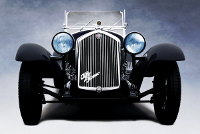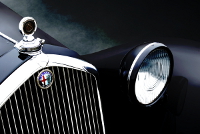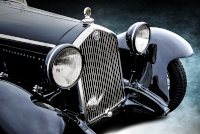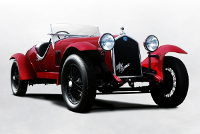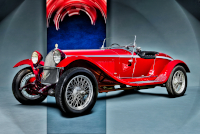Location:
Pebble Beach Concours d'Elegance, 2009
Owner: Ray Scherr | Westlake Village, California
Prologue:
While Pebble Beach would feature Alfa Romeo in 2010, its 60th concours d'elegance and the 100th anniversary of the marque, the 2009 edition included a special Zagato retrospective. No such exhibit would be complete without a 6C Alfa, the proverbial bread and butter of Zagato's fortune in the early classic era. And so "Class P: Zagato - 90 Years of Design," featured a trio of old Alfas—a 6C 1500, 6C 1750, and 8C 2300. Without raiding the 18th fairway, we've been fortunate to assemble a comparable lot of Zagato-bodied Alfas. But, not to tread over the same territory too many times, I like this example best for its former owner, L. Scott Bailey, founder of Automobile Quarterly.
As yet, I have completed a speck of the work he and his team accomplished. But it is my humble aspiration to work in a manner comparable to a digital revision of AQ, to seek foundational print materials, first-hand accounts when I can, and keep an eye on the broader context, (not simply the common rhetoric).
- - - - - - - - - -
► Image Source: Nikon D200 (10.2 MP)
References:
- Automobile Quarterly, Volume 7, Number 2, "Alfa Romeo 6C 1750" by Michael Lorrimer, The Kutztown Publishing Company, Inc., Kutztown, PA, page 200
- Czap, Nick. "Museo Storico Alfa Romeo: The catalogue" Giorgio Nada Editore, Milano, Italia. 2015, page 55
- The New York Times, July 15, 2012: "L. Scott Bailey, Founder of Automobile Quarterly, Dies at 87" by Paul Vitello
- Gooding & Company: Chassis #10814368 sold at Pebble Beach in 2008.
- UltimateCarPage: One of the better entries strolls through more than a dozen 6C 1750 galleries, by Wouter Melissen, January 16, 2014.
This all-black 1931 Gran Sport Spider was owned by L. Scott Bailey, founder and editor of Automobile Quarterly, making it the property of the man responsible for the seminal classic automotive publication. Automobile Quarterly began in 1962 (Volume 1, No. 1) and ran until 2012 (Volume 52, No. 1). So said The New York Times following Bailey's death in 2012, the publication addressed a void in material devoted to automotive history: "The hardcover periodical in the reader's hands, [Bailey] claimed, would fill that void four times a year in 100-plus pages—in full color and without advertising—containing lavishly illustrated articles of encyclopedic length and literary quality, all to 'reflect the grandeur, the majesty, the adventure that is the automobile.'" Bailey retired as editor in 1986. If our own little project can meet the standards set by Mr. Bailey, if only by a fraction, then we will have created a worthwhile survey for the online automobile enthusiast.
Chassis #10814368 wears its original coachwork. It is a Series V car, slightly more poised in its stance compared to earlier versions, yet still diminutive in stature. For a simple comparison point between series, review chassis #8513045. Between the two, this 1931 car enjoys more refined running gear and a somewhat more together appearance overall. Glancing over the series, it is somewhat astonishing how the 6C Alfa began as a cart with a supercharged, dual overhead-cam motor. The drivetrain benefits from advanced casting technology and skillful design to strain revs and horsepower out of fewer than two litres, and yet the platform remains an antique derivation. By the end of the decade, Alfa Romeo will have progressed by an order of magnitude, designing remarkably advanced sports cars by any 20th century standard.
Motor: 1,752 cc straight 6-cylinder, cast iron block, iron hemi-head | 65 mm x 88 mm | 5.0:1 compression | #10814368
Valvetrain: DOHC, 2 valves per cylinder
Aspiration: Memini DOA dual-choke carburetor, Roots-type supercharger
Power: 85 bhp @ 4,500 rpm
Drivetrain: 4-speed gearbox, rear-wheel drive
Front Suspension: beam axle, semi-elliptic leaf springs, friction dampers
Rear Suspension: live axle, semi-elliptic leaf springs, friction dampers
Architecture: pressed steel ladder-frame chassis with aluminum body by Zagato of Terrazzano di Rho, Lombardia
Kerb Weight: 920 kg (2,028 lbs)
Wheelbase: 2,745 mm (108.1 inches)
0-60: about 14.0 seconds
Top Speed: 145 km/h (90 mph)
Etymology:
'6C 1750' refers to the motor configuration, a straight 6-cylinder of about 1.75 litre displacement. 'Gran Sport' refers to the fourth series update of Alfa Romeo's well tested Super Sport platform, with the notable addition of a roots supercharger. The term 'spider' descends from the carriage trade, which in motorcar parlance came to refer to open sports cars. 'Zagato' is the Milanese coachbuilder who provided the aluminum coachwork.
Figures:
From 1929 to 1933, Alfa Romeo built a reported 2,579 examples of the 6C 1750, doing so in six different configurations over four successive development series. In truth, the 6C is a model split across the 6C 1500 (Series 1 and 2), and the 6C 1750 (Series 3 through 6). Note the chassis number chronology of this 1931 6C 1750 Gran Sport (#10814368) and the somewhat experimental 1933 6C 1500 Gran Sport Testa Fissa (#10814406). The 1500's chassis number is 38 clicks higher than this 1750, demonstrating the continuity of 6C series independent of the motor.
Taken as a whole, these figures make the 6C a volume production sports car at a time when the thing itself does not exist. Of total production, Alfa Romeo built 257 Gran Sport Spiders, all from 1930 to 1933. Of these, 213 comprise the 4th and 5th series from 1930 to 1932, whereas the 44 6th series cars are slightly more refined. Zagato most often provided the coachwork.
Value:
This particular car, chassis #10814368, sold at Gooding & Company's Pebble Beach Auction in 2008 for $1,320,000.
Series V: Subtle Changes for the Zagato-Bodied 6C 1750
This update does without chrome on the leading edge of the doors. Zagato also used an enlarged footwell vent in a rectangular arrangement, although this difference is not exclusive to the fifth series. Changes in wheel and tyre augment smoother, flowing running gear. Chassis #10814368 wears one of the most nicely enclosed set of fenders, with a more enveloping shape than many of its contemporaries. Also on this particular car, the doors are cut down, rather than straight, although this particular trait may not have been characteristic of any particular 6C Alfa series.
Spritely Proportions: Simple Lines and Balance
From the proper angle, the front wheels tuck nicely inside the front wings; note, however, that they still protrude ahead of the grille. The rear axle sits at the far opposite end, stretching the wheelbase. So the total effect is spider-like—elongated in profile, though pleasant from a quarter perspective. Further extending the overall length, many of these early Alfa spiders wear a double-continental kit. What would become a rather Cadillac-septuagenerian trait in the post-War era began as a sporting attribute. In the classic era, high speeds on rough roads demanded emergency preparedness, to say nothing of the grueling effort required to last an event like the Mille Miglia. I can only speculate at whether the added weight of the wheels and tyres affects the balance, or ends up negligible on account of the combined weight of the chassis and drivetrain.
Last Updated: Mar 26, 2025


